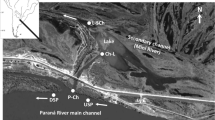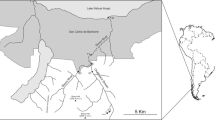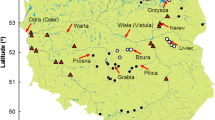Abstract
During the period from 1981-07-23 to 1981-08-10, the River Rhine, from the Alps to the North Sea, was sampled for chironomid pupal exuviae. Samples were also taken from the Grande Canal d'Alsace and from selected tributaries. In all 78 samples were taken, of which 9771 exuviae were examined and 135 taxa identified. A species list is given showing the distribution of taxa between the principal regions of the river (Appendix 1). Samples were also taken to show the ‘within-sample’ and ‘between-sample’ variability, and one pair of samples was used to demonstrate the difference between the two banks of the river below the junction with the Main. The Rhine above the Bodensee has a diverse fauna dominated by Orthocladiinae. The Hochrhein near the entry of the River Aare, and the River Aare itself, also have a diverse fauna, but include many sediment-dwelling Chironominae. Below Strasbourg the fauna changes markedly, losing most of its sediment-dwellers, and shows a great increase of pollution-tolerant species. The fauna generally becomes less diverse and of poorer quality throughout the Oberrhein sections, and faunal changes are demonstrated that are related to the inflow of the Rivers Neckar and Main, Samples from the Mittelrhein gorge and the Niederrhein are generally dominated by two species ofRheotanytarsus and show a progressive reduction of diversity coupled to an increase of pollution-tolerant species. The low proportions of sediment-dwellers in the Niederrhein and the Waal, suggests that the sediments are unsuitable for the support of a normal chironomid fauna.
Similar content being viewed by others
References
BLOETSCH, J., 1977. Bodenfaunistische Untersuchungen in Aare und Rhein Schweiz. Z. Hydrol., 39: 46–67.
BLOETSCH, J., 1980. Bodenfaunistische Untersuchungen in Aare und Rheim. Schweiz. Z. Hydrol., 42:285–307.
CASPERS, N., 1980a. Die Makrozoobenthos-Gesellschaften des Hochrheins bei Bad Säckingen. Beitr. naturk. Forsch. SüdwDtl., 39: 115–142.
CASPERS, N., 1980b. Die Makrozoobenthos-Gesellschaften des Rheins bei Bonn. Decheniana, 133: 93–106.
CZEKANOWSKI, J., 1913. Zarys method statystycznych (Die Grundzuge der statistischen Methoden). Warsaw.
ELLIOTT, J.M., 1971. Some methods for the statistical analysis of samples of benthic invertebrates. Freshwat. Biol. Ass. Sci. Publ. No. 25.
FERRARESE, U., and ROSSARO, B., 1981. Chironomide 1. Guide per il riconoscimento delle specie animali delle acque interne Italiane, 12. Consiglio Nationale delle recherche AQ/1/129.
FORSTNER, U., and G.T.W. WITTMAN, 1979. Metal Pollution in the Aquatic Environment Springer-Verlag, Berlin.
FRIEDRICH, G., and D. MULLER, 1984. Rhine. In: Whitton, B.A., Ed., Ecology of European Rivers. Blackwell, Oxford.
KINZELBACH, R., 1978. Veränderung der Fauna des Oberrheins. Beih. Veröff. Naturschutz Landschaftpflege Bad Württ. 11: 291–301.
KLINK, A.G., 1982a.Rheopelopia ornata (Meigen): Description of the metamorphosis and ecology of river inhabiting Tanypodinae-larva, new to the Dutch fauna (Diptera; Chironomidae). Ent. Ber. 42: 78–80.
KLINK, A.G., 1982b. Onderzoek aan de makro-invertebraten in de grote Nederlandse rivieren. Hydrobiologisch Adviesburo A.G. Klink, Wageningen.
KLINK, A.G., 1983.Rheotanytarsus rhenanus n. sp., a common midge of the lithorheophilic fauna in large lowland rivers (Diptera, Chironomidae). Ent. Ber., Amsterdam.
KNOPP, H., 1957. Die heutige biologische Gliederung des Rheinstroms. Deutsche Gewässerkundliche Mitt. 1:57–63.
LANGTON, P.H., 1980. Taxonomy and Biology of some British Chironomidae. PhD Thesis, Polytechnic of the South Bank, London.
LANGTON, P.H., 1984. A key to pupal exuviae of British Chironomidae. Private publication.
LAUTERBORN, R., 1916–1918. Die geographische und biologische Gliederung des Rheinstroms. Sitz. Ber. Heidelbg. Akad. Wiss., Math-Naturw. Kl. Abt. B 1916, VIIB 6: 1–61; VIIIB 5: 1–70; 1918, IXB 1: 1–87.
McGILL, J.D., 1981. Distribution of Chironomidae (Diptera) throughout the River Chew drainage system, Avon, England. PhD Thesis, University of Bristol, England.
MENHINICK, E.F., 1964. A comparison of some species diversity indices applied to samples of field insects. Ecology 45:859–861.
MULLER, G. 1979. Schwermetalle in den Sedimenten des Rheins-Veränderung seit 1971. Umschau 79 24:778–783.
RAT VON SACHVERSTANDIGEN FUR UNWELTFRAGEN 1976. Umweltprobleme des Rheins. 3. Sondergutachten vom März 1976. Stuttgart, Mainz (W. Kohlhammer).
REISS, F., 1968. Okologische und systematische Untersuchungen an Chironomiden des Bodensees. Ein Beitrag zur lakustrischen Chironomidenfauna des nördlichen Alpenvorlandes. Arch. Hydrobiol. 64: 176–323.
RUSE, L.P. and R.S. WILSON, 1983. The monitoring of river quality within the Great Ouse basin using the Chironomid Exuvial Analysis Technique. Wat. Pollut. Control. 83: 116–136.
SAY, P.J. and B.A. WHITTON, Eds., 1981. Heavy metals in Northern England: Environmental and Biological Aspects. Department of Botany, University of Durham.
SHANNON, C.E. and W. WEAVER, 1963. The Mathematical Theory of Communication. University of Illinois Press, Urbana.
SØRENSON, T., 1948. A method of establishing groups of equal amplitude in plant sociobiology based on similarity of species content, and its application to analyses of the vegetation on Danish Commons. Biol. Skr. 5: 1–34.
THIENEMANN, A., 1910. Das Sammeln von Puppenhäuten der Chironomiden. Eine bitte um Mitarbeit. Arch. Hydrobiol 6: 213–214.
THIENEMANN, A., 1954. Chironomus. Leben, Verbreitung und wirtschaftliche Bedeutung der Chironomiden. Binnengewässer 20: 1–834.
WALSHE, B. M., 1950. Observations on the biology and behaviour of larvae of the midgeRheotanytarsus. J. Quekett microsc. Club 3: 171–178.
WILSON, R.S., 1977. Chironomid pupal exuviae in the River Chew. Freshwat. Biol. 7: 9–17.
WILSON, R.S., 1980. Classifying rivers using chironomid pupal exuviae. In: D.A. Murray, Ed., Pergamon Press, Oxford.
WILSON, R.S., 1976–1982. Biological classification of rivers. Unpublished reports to the Department of the Environment, London.
WILSON, R.S. The distance chironomid exuviae drift in streams (in prep.).
WILSON, R.S. and J.D. McGILL, 1979. The use of chironomid pupal exuviae for biological surveillance of water quality. Tech. Memo. No. 18, Department of the Environment, Water Data Unit, Reading.
WILSON, R.S., and J.D. McGILL, 1982. A Practical Key to the Genera of Pupal Exuviae of the British Chironomidae, University of Bristol Printing Office, Bristol.
WILSON, R.S. and S.E. WILSON, 1983. A reconaissance of the River Rhine using Chironomidae pupal exuviae (Diptera: Insecta). Mem. Amer. Ent. Soc. 34: 361–385.
Author information
Authors and Affiliations
Rights and permissions
About this article
Cite this article
Wilson, R.S., Wilson, S.E. A survey of the distribution of chironomidae (Diptera, Insecta) of the river rhine by sampling pupal exuviae. Hydrobiological Bulletin 18, 119–132 (1984). https://doi.org/10.1007/BF02257051
Issue Date:
DOI: https://doi.org/10.1007/BF02257051




